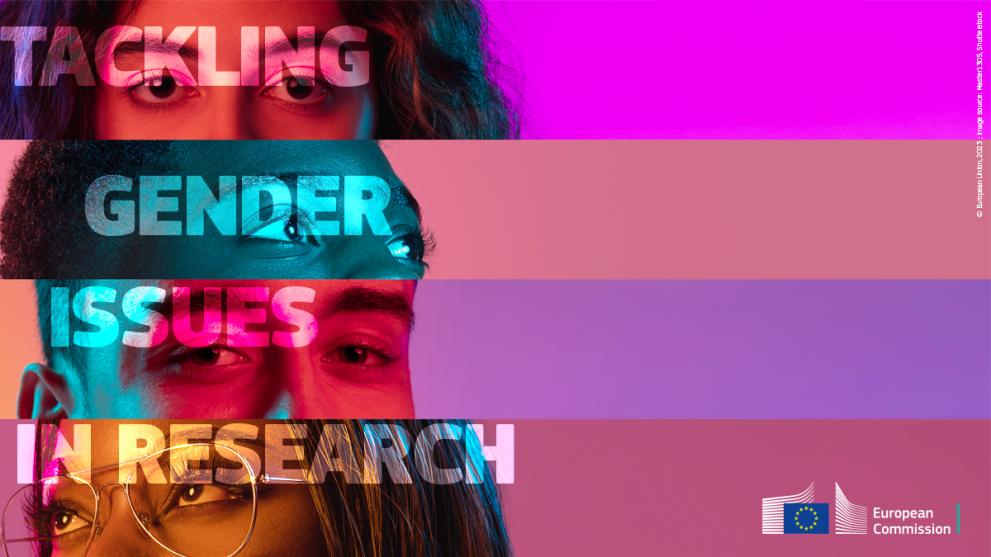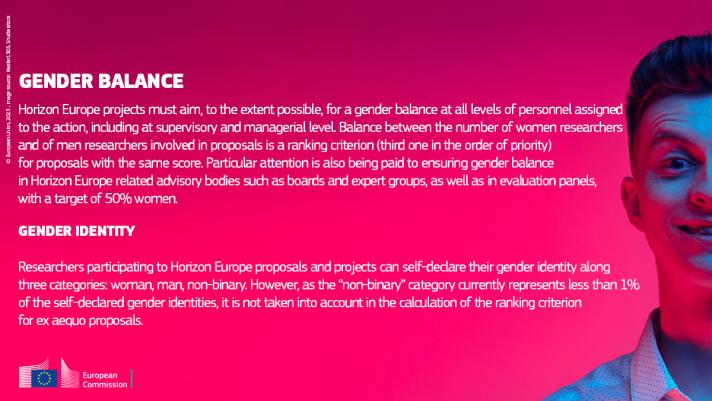
Understanding how gender plays a vital role in research and innovation allows us to address the diverse needs of citizens of the European Union. It enhances the societal relevance of the knowledge, technologies and innovations produced, and contributes to the production of greater goods and services.
On the occasion of the International Women’s Day on 8 March, the European Executive Research Agency (REA) would like to invite you to discover how the EU tackles gender inequalities and to learn what gender-related terminology means. If you are a prospective beneficiary of Horizon Europe funding, this could help you prepare your project proposal.
- What is the difference between gender dimension and gender balance in research?
Gender balance is the balance between women and men in research teams who will implement a project. Horizon Europe projects should aim to have an even, 50/50 participation rate of both men and women amongst teams and in leading roles. In Horizon Europe, gender balance among researchers is a ranking criterion for proposals with the same evaluation scores.
The gender dimension implies analysing and taking into account the possible differences between men and women (biological characteristics as well as the social and cultural features), boys and girls, or males and females, in the R&I content of the project. Integrating this gender dimension is now a mandatory requirement in all research and innovation projects across Horizon Europe, unless a topic explicitly specifies otherwise.
Gender equality provisions in Horizon Europe cover both of the afore-mentioned aspects. For further information, see here, as well as in the Horizon Europe Programme Guide in the section dedicated to gender equality and inclusiveness.
- How can we address the gender dimension in a research project?
Sex
Refers to biological characteristics (including genetic, hormonal, physiological, anatomical) that distinguish between male, female, and intersex (in humans) or hermaphrodite (in non-human animals).
Gender
Refers to socio-cultural norms, identities and relations that, together, shape and sanction what are considered “feminine” and “masculine” behaviours, and structure societies and organisations.
Intersectionality
Factors such as racial or ethnic origin, age, socioeconomic status, sexual orientation, or disability, combine with sex and gender to shape a person’s or a group’s experience and social opportunities, thereby influencing the form of discrimination and inequality encountered.
In the R&I lifecycle, addressing sex and gender can appear challenging. However, examples in many fields show otherwise. For example, in pharmaceutical drug prescribing it can start with simple yet powerful steps, from including female and male cells, tissues and organisms throughout the testing process to reporting all data disaggregated by sex. These approaches can provide the knowledge needed to develop sex-specific dose adaptations of existing drugs, such as desmopressin or zolpidem, and may lead to gender-specific treatments in the future.
Researchers, physicians, pharmacists and patients should also consider gender differences in how symptoms are experienced and expressed. What is reported and how it is reported affect which diagnostic steps occur, and which medications are prescribed.
This example and many others can be found in the EU’s ‘Gendered innovations 2’ report. This policy report produced by the EU funded Horizon 2020 expert group on ‘Gendered Innovations’ provides researchers and innovators with methodological tools for sex, gender and intersectional analysis and with concrete case studies in fields of relevance for Horizon Europe.
- What are the Gender Equality Plans?
With Horizon Europe, the Commission strengthened its commitment to gender equality by making the possession of a Gender Equality Plan (GEP) an eligibility criterion for all higher education establishments, research organisations, as well as public bodies from Member States and Associated Countries applying for the programme. To comply with the Horizon Europe GEP eligibility criterion, a GEP must meet four mandatory process-related requirements:
- Public document: The GEP must be a formal document published on the institution’s website, signed by the top management, and actively communicated within the institution.
- Dedicated resources: a GEP must have dedicated resources and expertise in gender equality to implement the plan.
- Data collection and monitoring: organisations must collect sex/ gender disaggregated data on personnel (and students, for the establishments concerned) with annual reporting based on indicators.
- Training: The GEP must also include awareness-raising and training actions on gender equality.
In addition to these four mandatory requirements, there are five recommended content-related (thematic) areas that organisations may wish to consider in their GEP:
- Work-life balance and organisational culture
- Gender balance in leadership and decision-making
- Gender equality in recruitment and career progression
- Integration of the gender dimension into research and teaching content
- Measures against gender-based violence, including sexual harassment
For further information and guidance on the GEP eligibility criterion visit: Gender equality in research and innovation | European Commission (europa.eu)
- What are the main EU funding opportunities managed by REA for applicants working on gender equality?
There is specific funding for research related to gender equality under Horizon Europe. For more information on gender-related funding opportunities and topics, please read the ‘Widening Participation and Strengthening the European Research Area’ Work Programme 2023-2024 and the ‘Culture, Creativity and Inclusive society’ Work Programme 2023-2024 Examples include two Horizon Europe calls for proposals that target gender equality opened under the WIDERA-2023-ERA programme with a deadline of 9 March 2023.
- Policy support to facilitate the implementation of a zero-tolerance approach towards gender-based violence in the ERA
- Support to the implementation of an EU Manifesto for STE(A)M education and research and innovation career paths to tackle gender inequalities in the ERA
There are two new upcoming Horizon Europe calls for proposals under the HORIZON-WIDERA-2024-ERA programme, with calls opening on 6 December 2023, with a deadline of 12 March 2024.
- Support to the implementation of inclusive gender equality plans
- Policy coordination to support all aspects of inclusive Gender Equality Plans and policies in the ERA
- Gender-roles in extremist movements and their impact on democracy (opening 4 October 2023)
Funding to promote gender equality is also provided through other actions. Examples include establishing an EU Gender Equality Competence Facility, introducing the first EU award for Gender Equality Champions and continuing to monitor the state of gender equality in R&I through the She Figures publications as well as through the MSCA. The winners of the award will be announced on International Women’s Day by Mariya Gabriel, Commissioner for Innovation, Research, Culture, Education and Youth. You can Watch the ceremony live online from 13:00 to 14:00 CET on the 8 March 2023.
- What is REA’s role in supporting Gender Equality in research and innovation?
REA has an extensive portfolio of projects funded under the Horizon 2020 Science and SwafS programme, supporting a critical mass of European universities, research centres and national authorities. These participating institutions became catalysts at ERA level for promoting the design and implementation of Gender Equality Plans, which now have become an eligibility criterion in Horizon Europe. Some examples of REA-managed projects that have successfully addressed gender aspects can be seen in the following:
‘Inclusive Health and Wellbeing in Small and Medium Size Cities’
The INHABIT project is mobilising existing resources, such as culture and heritage, food, human-animal bonds, and art and the environment to boost health and wellbeing in cities. In particular, it is working on gendered landscape, integrating the gender, diversity, equality, and inclusion approach (GDEI) in urban development. To this aim, the project is providing a set of tools - such as the geographical mapping of gender urban experiences - and good practices - such as gender mainstreaming - that can guide cities in becoming more inclusive through adequate sustainable urban development.
‘Gender-based violence and institutional responses, building a knowledge base and operational tools to make universities and research organisations safe’
The UNISAFE project aims to produce better knowledge on gender-based violence (GBV) and sexual harassment in research performing organisations. The aim is to translate the generated understanding into operational tools and recommendations for higher education, research organisations and policymakers. To achieve this goal, the project proposes to investigate the mechanisms of GBV over a three year time period – social determinants, antecedents and consequences – by developing a 7P model (covering prevalence, prevention, protection, prosecution, provision of services, partnerships and policy), that will be used to collect, analyse and synthesise qualitative and quantitative data. These results will be translated into policy recommendations and a toolbox for universities and research organisations.
‘Innovative Machine Learning to constrain Aerosol-cloud Climate Impacts’
The IMIRACLI project brings together leading climate and machine learning scientists across Europe with non-academic partners to educate a new generation of female climate data scientists. This Marie Skłodowska-Curie Innovative Training Network (ITN) funds 15 PhD students across Europe in developing machine learning solutions to deliver breakthroughs in climate research. This is done by tracing and quantifying the impact of aerosol-cloud interactions from the microscale to the large-scale in our climate. IMIRACLI is fully committed to gender equality and the advancement of women’s careers in science, visible in the Gender Action Plan that clearly sets out the aspiration and obligations of the entire consortium in ensuring gender equality throughout the project.
More information:
Gender equality in research and innovation
Gender Equality Strategy 2020-2025
The European Charter & Code for Researchers
Cordis Result Pack on gender equality in research
ACT Videos | ACT (act-on-gender.eu)
Celebrating the International Day of Women & Girls in Science 2023
Common mistakes to avoid when applying for Horizon Europe funding
Details
- Publication date
- 7 March 2023
- Author
- European Research Executive Agency




